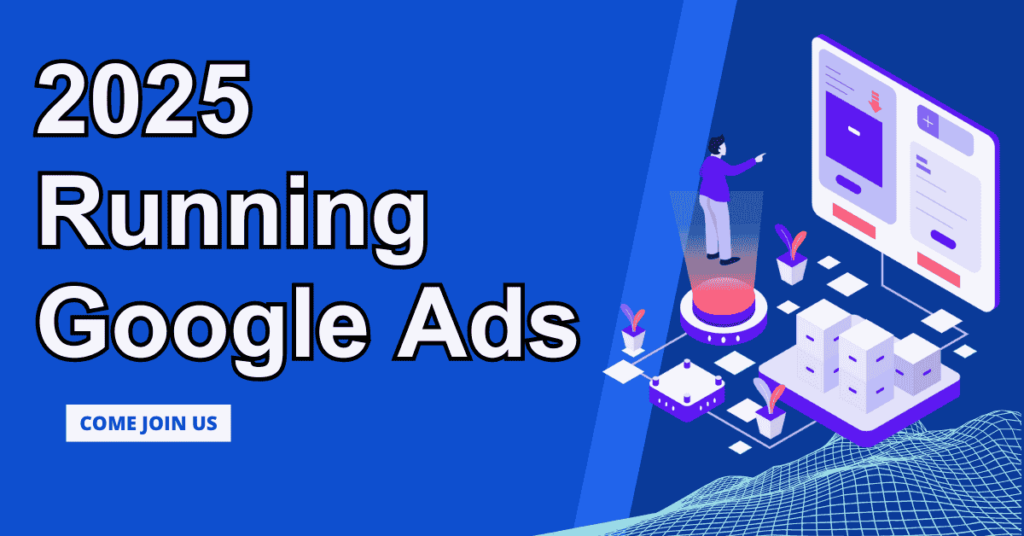Running Google Ads successfully in 2025 requires a strategic approach that integrates new trends, AI, and the evolution of consumer behavior. Here’s a comprehensive guide on strategies to manage your Google Ads campaigns in 2025:

1. Embrace AI and Automation- Google Ads in 2025
Google Ads is increasingly automated. Leveraging AI can significantly improve campaign performance.
- Smart Bidding: Use machine learning-based bidding strategies like Target CPA, Target ROAS, and Enhanced CPC. These strategies use data to automatically adjust bids in real-time to optimize conversions.
- Performance Max Campaigns: This new campaign type allows advertisers to target customers across all Google’s inventory (Search, Display, YouTube, Gmail, etc.) using automation for creatives, bids, and placements.
- Automated Creative Suggestions: Use Responsive Search Ads and Responsive Display Ads, which automatically adjust creatives to match search terms and user behaviors.
2. Focus on First-Party Data
With the increasing importance of privacy and the phase-out of third-party cookies, first-party data (data collected from your own customers) will become critical.
- Customer Match: Upload your customer lists to Google Ads for tailored ads. Segment these lists for retargeting, upselling, or cross-selling.
- Google Analytics 4 (GA4): GA4 emphasizes first-party data and cross-device tracking, which helps build more refined audience lists for Google Ads campaigns.
3. Use Audience Segmentation and Targeting- Google Ads in 2025
- In-Market Audiences: Target users who are actively researching or intending to purchase products or services similar to yours.
- Affinity Audiences: These are for people based on their long-term interests, lifestyles, and buying patterns.
- Customer Segmentation: Use Google’s advanced audience features to create segments based on behavior, interests, location, or demographics.
4. Enhanced Attribution Models
- Data-Driven Attribution (DDA): DDA is Google’s default model in 2025, which uses machine learning to understand how different ads, keywords, and campaigns influence conversions.
- Cross-Device Conversions: Leverage Google’s ability to track users across devices to better understand your customer journey.
- Offline Conversions: Integrate offline conversion tracking to measure leads or sales that happen off the web (like phone calls or in-store purchases).
5. Optimize for Mobile and Voice Search
- Mobile-First Ads: Ensure your landing pages are mobile-optimized. Use mobile-specific bid adjustments and create mobile-friendly ads to capture users on the go.
- Voice Search Optimization: With the growing usage of voice assistants, target longer, conversational search queries and use more natural language in ad copy. Use local search ads optimized for “near me” queries to capture voice traffic.
6. Creative and Copy Strategies- Google Ads in 2025
- Dynamic Creative Optimization (DCO): Use Google’s Dynamic Ads to automatically personalize ad content based on user behavior and preferences. This helps to ensure your ads are more relevant to individual users.
- Ad Customizers: Include custom parameters in your ads, such as countdown timers or pricing tailored to the user’s context.
- Storytelling in Ads: Create compelling narratives in video ads or display creatives. Google Ads in 2025 will prioritize engaging, meaningful content, especially on YouTube.
7. Leverage Video Ads
Video consumption continues to grow, making YouTube an essential platform.
- YouTube Shorts Ads: Leverage short-form content ads (15–30 seconds) to engage viewers in bite-sized formats.
- TrueView for Action Ads: These video ads drive actions like clicks or conversions, making them perfect for performance marketing goals.
- Video Shopping Ads: Use video shopping ads on YouTube to link directly to your product pages, enhancing the shoppable video experience.
8. Local and Hyper-Targeted Campaigns
- Google My Business (GMB) Integration: Ensure that your GMB profile is up-to-date, as local campaigns will continue to use it to serve ads to local users searching for businesses.
- Geo-Fencing and Proximity Targeting: Use hyper-local targeting by setting up specific geographic areas for your ads. Serve ads to people who are physically near your business or event.
- Local Inventory Ads: If you own a retail store, use these to show product availability in nearby stores in real-time.
9. Enhanced Shopping and E-commerce Campaigns
- Performance Max for Retail: These campaigns integrate Shopping ads with Google’s display, search, and YouTube networks to provide holistic performance-driven campaigns.
- Product Feed Optimization: Ensure your product data feed is optimized with rich product descriptions, high-quality images, and up-to-date inventory data to maximize Shopping Ad results.
- Google Merchant Center Insights: Use this tool to track product performance, consumer demand, and competitor pricing to stay ahead in e-commerce advertising.
10. AI-Powered Keyword Strategies- Google Ads in 2025
- Broad Match and Negative Keywords: Combine Google’s broad match targeting with a comprehensive negative keyword list to capture long-tail keywords while filtering out irrelevant traffic.
- Auto-Suggestions: Use Google’s keyword planner and dynamic ad suggestions to stay up-to-date with keyword trends. AI-powered suggestions can identify new opportunities faster than manual keyword research.
11. Conversion Rate Optimization (CRO)
Improving your landing page experience is key to maximizing ad spend efficiency.
- Page Speed Insights: Use Google’s tools to ensure fast-loading pages, as slow speeds can negatively impact Quality Score and conversion rates.
- A/B Testing: Constantly experiment with different landing page designs, CTAs, and messaging to identify the highest-performing variants.
- Interactive Elements: Consider adding interactive elements such as quizzes, forms, or product recommendations to increase engagement on landing pages.
12. Ad Extensions and Structured Snippets
- New Extensions: Utilize the latest extensions (e.g., image extensions, location extensions, and callout extensions) to provide more information to users upfront.
- Structured Data Markup: Integrate structured snippets to display key product details, pricing, and reviews in your search ads.
13. Privacy-First Approach- Google Ads in 2025
As privacy regulations tighten globally, it’s critical to prioritize user data protection.
- Consent Management: Implement proper consent management tools on your website to ensure compliance with data privacy laws such as GDPR, CCPA, and others.
- Contextual Targeting: With the reduced reliance on third-party cookies, focus on contextual targeting strategies that rely on the content of the web page rather than individual user behavior.
14. Sustainable Advertising
Consumers are increasingly favoring sustainable and ethical brands.
- Highlight Sustainability: Incorporate your brand’s sustainability initiatives into your ad copy, especially if your products are eco-friendly or ethically produced.
- Google’s Carbon Impact: Google’s efforts to reduce the carbon footprint of digital ads will influence rankings, so consider running campaigns that align with their sustainability goals.
Conclusion
Running Google Ads in 2025 requires a blend of AI-powered automation, data-driven targeting, and attention to evolving privacy concerns. Focus on personalization, mobile optimization, and using advanced attribution models to optimize your ad spend. Adapt your strategy to stay aligned with technological advancements and shifting consumer behavior, ensuring a competitive edge in the digital advertising landscape.
